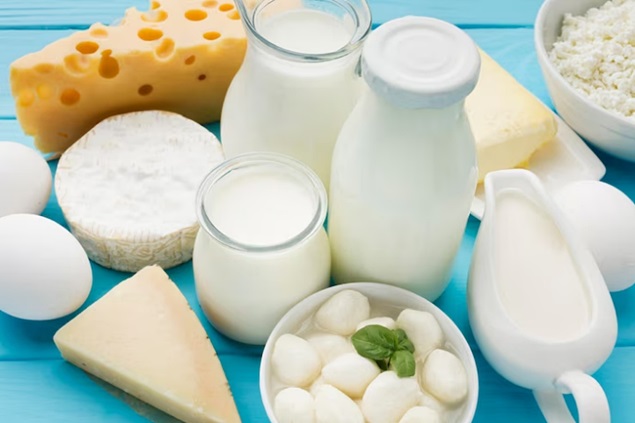
Rich. Creamy. Full of consistency. Sweet. For decades, these have been the characteristics of many products that tantalize our taste buds. And over time, the food industry has relied on sugar, fats, and oils to provide these flavor and texture benchmarks in a wide variety of foods and beverages, from frozen meals to sauces, especially in the dairy products category, where taste and texture reign supreme. But how do you meet this consumer demand while also producing dairy products that align with the "clean label" trend? One answer can be found in Cargill's study, "Taking the lead in label-friendly dairy," from which we present the key findings in this issue of our magazine.
Interest in less processed foods
As consumers' attitudes toward food products in general (and specifically, processed foods) change, with increasing concerns about health, environmental impact, and animal treatment, the use of many functional ingredients that provide these functions has come under greater scrutiny.
In today's landscape, consumers are increasingly interested in knowing where ingredients come from, how raw materials are obtained or manufactured, and whether they are natural or modified, using chemicals.
These attitudes have a profound impact on the products consumers want to buy and, in turn, on food formulation. According to a recent report by Health Focus International (HFI), 35% of global consumers have stated that they reduced their consumption of processed foods in the past year.
The report further stated that many shoppers worldwide are now much more focused on ingredients they recognize and would use at home.
A revolution
These attitudes are driving a revolution in the dairy product segment. While dairy products have long been seen as an important part of a healthy and balanced diet, consumers are branching out, showing strong interest in dairy alternatives with label-friendly ingredients.
This category is expected to grow dramatically in the coming years. For example, the global market for dairy alternatives is expected to reach $2.6 billion in 2020 and is projected to reach $3.2 billion by 2023.
Certain ingredients are of particular concern to shoppers, including preservatives, trans fats, saturated fats, food colorings, and artificial sweeteners. While these changes are occurring globally, the shift has been especially significant for dairy products.
Milk consumption has declined by 22% over the past two decades, driven by an aging population with health and weight management concerns, as well as growing consumer interest in plant-based alternatives.
For instance, plant-based substitutes are clearly a rapidly expanding category, with revenues of nearly $2.3 billion in 2019, according to Eurostat data. But other categories of plant-based substitutes are estimated to grow by 50% by 2023.
A significant opportunity
Despite the increased interest in less processed foods and beverages, there is still a significant market opportunity. Processed foods and beverages continue to offer essential benefits to many consumers, especially in households with children and among consumers who value convenience.
According to the HFI report, 6 out of 10 global consumers say they remain loyal to processed foods and beverages, and added costs for unprocessed foods are a significant obstacle to purchasing them.
Nutrition, taste, and convenience are particularly important to parents. More than half say they appreciate these products for preserved nutrients, fortification, good taste, and convenient formats. Essentially, today's consumers want it all. Products that can meet both the specific needs of modern households (especially those with children or busy adults) and those that offer consistent nutrition and great taste.
Changing attitudes are reshaping the dairy product landscape worldwide as brands work to keep pace with these nuances in consumer thinking. This doesn't mean it's an all-or-nothing proposition.
For example, while dairy product consumers in the European Union and the United States are fairly open to dairy alternatives, half now consume both real dairy products and dairy alternatives at least occasionally. They may have a preference for real dairy products, but they no longer believe that real dairy products are the only choice.
Taste, a big issue
Ingredients are particularly important in the dairy product category. Two out of three respondents expect dairy products to have fewer ingredients, and more than half read the ingredient list to determine if a dairy product is healthy or highly processed. That being said, whether it's real dairy products or an alternative, the taste of the products is still a significant concern.
According to Cargill's proprietary research, the majority of respondents still prefer the taste of real dairy products over alternatives. Excellent taste remains the most important purchasing factor in every dairy product segment, although it tends to be most critical in indulgent dairy segments such as ice cream and flavored milk.
However, for dairy alternatives, Cargill's findings suggest that the role of healthy ingredients and nutrition is not as relatively important compared to excellent taste.
The implications of all this are significant for brands and product formulators. Consumers clearly prefer products with low sugar content and label-friendly ingredients.
However, this doesn't mean they will accept products that deviate too much from their traditional preferences in terms of taste and texture. However, eliminating functional ingredients that provide sweetness and texture, such as sugar and emulsifiers, is a challenging proposition, especially in dairy products.
As little sugar as possible
A recent Innova Market Insights report, for example, found that many of these products still tend to have high sugar content. As efforts to reduce sugar consumption in processed foods increase and as consumers take further steps to reduce sugar intake in dairy beverages, the high sugar content in other dairy products, such as desserts and yogurts, will become even harder to defend in the future. Taste and texture go hand in hand. Removing sugar is a prime example.
When you remove it, there's a significant gap to fill. Sugar has a profound impact that goes beyond the sweet flavor of a product. Even if you add a high-intensity sweetener to compensate for the lack of sweetness, the old taste perception still needs to be replaced. Reducing fats is another key goal for many brands, and combined with the loss of sugar, it can significantly impact the overall texture of a product.
Although taste has often been considered a primary attribute of a product in consumers' minds, texture is also essential for a product's success, and in dairy products, both are fundamental in creating a product that meets consumer expectations, such as yogurt. In general, consumers have high taste expectations for dairy products and assume that alternative products are similar in taste and texture to their conventional counterparts.
Beyond taste and texture, these ingredients also make important contributions to other functionalities, such as product shelf life. The idea is that removing one or more of these ingredients is rarely a one-to-one substitution, so product developers need to take a different approach to formulation, sometimes using multiple solutions to achieve the right taste and texture goals.
Multiple solutions
As consumers become more educated about ingredients, what they are willing to accept in terms of taste and texture changes with their desire for healthy and transparent ingredients. Product formulators just need to provide products that check the right boxes. And now, there are many label-friendly ingredient solutions to help with texturing and sweetening dairy products.
Stevia
Stevia and erythritol, high-intensity alternative sweeteners, have become an important part of the product formulator's toolbox. Stevia is a plant extracted from the leaves of the Stevia rebaudiana plant native to Latin America. The active compounds in stevia are steviol glycosides, which are 150 times sweeter than sugar and heat-stable.
A variety of high-intensity sweeteners made from the stevia leaf, as well as stevia sweeteners made through fermentation to obtain a cost-effective source of Reb M and D (the best-tasting parts of the leaf), are now available and can mimic the sweet taste of sugar while keeping calories in check in numerous applications.
Stevia leaf extracts and stevia sweeteners can be used to provide optimal sweetness for different product applications while achieving sugar reduction goals between 30% and 100%. However, stevia may not always work alone, so it is often combined with other bulk sweeteners like erythritol to help mask the bitter notes created at high usage.
Chicory Root Fiber
A naturally sourced fructan containing inulin (a well-studied prebiotic fiber), chicory root fiber is a workhorse in formulating label-friendly products for a variety of categories, including baked goods, beverages, confectionery, dairy, and snack foods.
Chicory root fiber can contribute to various product formulation functions, such as use as a masking agent or a mimetic of fats, as well as enhancing mouthfeel, texture, and flavor of the product, as it bulks up for carbohydrates and zero-calorie sugars.
Pea Protein
Pea protein is extracted from green and yellow peas and can replace dairy ingredients in applications like ice cream and milk. It has become a functional ingredient for label-friendly texturing, as beyond adding protein, peas can emulsify, bind water, and provide a clean flavor. However, it's important to note that legumes are not a complete protein, meaning they do not contain all essential amino acids.
However, pea protein can be paired with complementary protein sources to achieve higher quality protein content and works as an excellent non-allergenic option in products intended for individuals sensitive to soy, gluten, lactose, and dairy.
Hydrocolloids
Hydrocolloids have been widely used in food applications to improve quality and shelf life. Pectin and carrageenan fall into this category. In dairy, they typically serve as gelling agents for products such as ice cream and desserts.
Pectin helps reduce sugar in beverages by providing body and texture lost when sugar is removed. It also enhances the enjoyment factor in acidified protein beverages by protecting the protein, which coagulates when acidity is added. Carrageenan, extracted from red seaweed, can serve as a thickening and emulsifying agent in food applications such as frozen desserts and dairy products.
Addressing the challenges
As label-friendly ingredients become a new standard in dairy products and other foods and beverages, formulation in this new era is now more complex. Companies need to spend more time learning how certain ingredients work and work to rebuild sweetness and texture without key ingredients like sugar and oils.
Ingredient suppliers are now pushing research to address common texturing challenges with label-friendly solutions, which are becoming increasingly detailed in meeting consumer expectations.
The following are some key rules in this new era of label-friendly dairy product formulation:
Taste and Texture
When it comes to "friendly" products, consumers still want them to taste and perform as expected, and this involves defining texture goals early in the formulation process.
Product formulators should expect some trial and error and should consider collaborating with a supplier that has a wide portfolio of sweetness and texture solutions, as well as broad formulation expertise to meet their goals.
Convenience and Sales
As mentioned earlier in this report, many consumers (nearly half globally) believe that processed foods and beverages are important for the convenience they offer. Many, especially those with children and busy lifestyles, continue to indicate a strong need for healthy and nutritious products that are also safe, convenient, and don't spoil too quickly on the shelf. Brands have the opportunity to communicate the positive aspect of processing while also helping consumers understand that it doesn't have to have a negative impact on nutrition.
Transparency
As consumers learn more about ingredients and more sustainable foods that are less processed, they are more likely to demand transparency from the products they buy.
Companies would do well to step up their transparency efforts and provide strong education on the texture and sweetness solutions they use and the functions they offer.
Many consumers still don't have a strong understanding of the attributes these ingredients provide, so there is a solid opportunity to provide simple and straightforward communications about how their products are made.
Consumers will be increasingly interested in foods and beverages that have a story about the product's history, where it comes from, and how it's made. These are now open to small, even unknown brands that provide this story.
Innovation
Product formulation in dairy and other foods and beverages is now a rapidly evolving business. Product formulators will need to stay current with changing consumer attitudes to address ongoing and nuanced requirements for taste, nutrition, and unique texture.
Taking it to the next level needs to remain top of mind in management thinking, and companies that don't continually seek better ingredients and solutions may find themselves missing the boat to success in the rapidly expanding dairy category.




